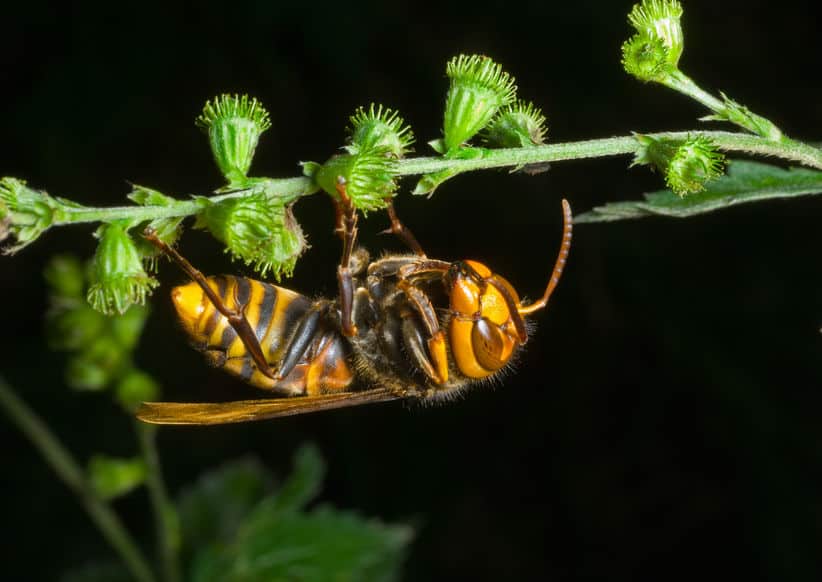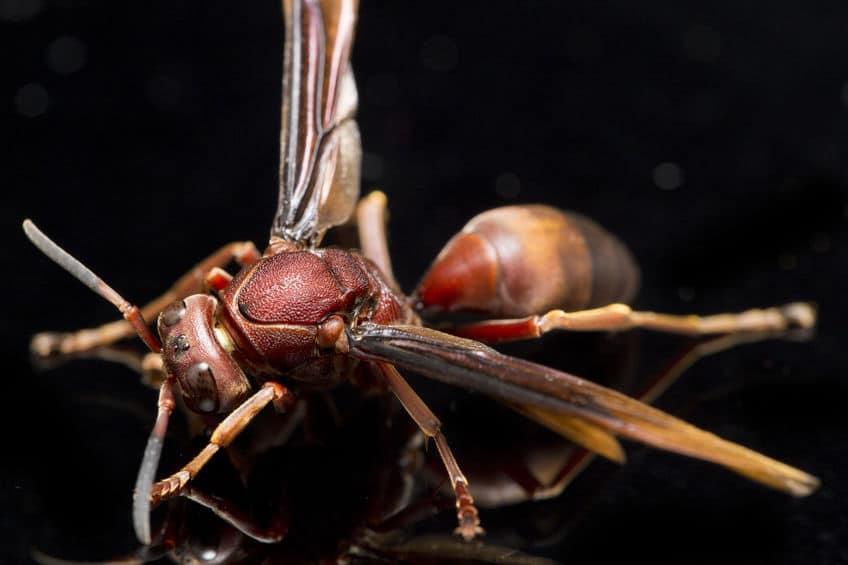Since 2019 the Asian giant hornet (Vespa mandarinia) also known as the ‘murder hornet’ has been discovered in areas of North America for the first time. This is a big concern for the local honey bee population. The red paper wasp by contrast is native to North America. But how do the two compare?
The Asian giant hornet, also known as the ‘murder hornet’ is bigger than the red paper wasp measuring about a third longer on average at 1.8 inches (4.5 cm) compared to 1.2 inches (3cm). The murder wasp is very different in appearance with a rounder body and black and yellow bands, compared to the reddish-brown and more slender build of the red paper wasp. Also, the red paper wasp has a more painful sting according to the Schmidt insect pain index.
Let’s compare the two in more detail.
Location
Where is the murder hornet found?
The murder hornet is found through Eastern and South-Eastern Asia. In Japan where it is common, it is known as the ‘giant sparrow bee’. More recently, however, it has gained the nickname of ‘murder hornet’.
Since 2019 there have been sightings in parts of North America, particularly in the Vancouver area. If it does get a foothold in North America then this invasive species would certainly disrupt the current balance in the ecosystem, with potentially very negative effects on local honey bee populations as they target them. Attempts are being made to eradicate them before it’s too late.
Where is the red paper wasp found?
The red paper wasp is native to the United States and found across the country and has even be seen as far north as Canada. It typically lives in woodland, but it is not uncommon for it to build its nest in sheltered areas around housing such as eaves and sheds.
Size
How big is the murder hornet?
The murder hornet is the largest social wasp in the world measuring up to 1.8 inches or (4.5 cm) long and with a wingspan of 3 inches (7.5cm). It also has a very big stinger measuring 0.2 of an inch (6mm)
How big is the red paper wasp?
Red paper wasps grow up to 1.2 inches (3 cm) in length. With a wingspan of up to 1 inch (2.5 cm).
Appearance
What are the distinctive features of the murder hornet?
The ‘murder hornet’ has grey wings, brown antennae, a dark brown almost black thorax (the part of the wasp behind its head), and the abdomen has distinct bands of dark brown and yellow.
It also has a distinct extended ‘tooth’ on its mandibles (claw-like) mouthparts, that it uses for digging.

What are the distinctive features of the red paper wasp?
The red paper wasp has a distinctive reddish-brown coloring, which is strikingly different from other common wasps such as the hornet and the yellowjacket.

Food
What do Asian giant hornets eat?
Murder hornets raid honey bees’ nests. They will attack a honeybee colony in force and shockingly can eradicate a honey bee colony in as little as two hours. They like the honey, but they also target the honey bee larvae.
In Asia where the hornet and the bees have evolved together, the bees have developed defense mechanisms. The bees have evolved to literally wrap themselves around the hornets in balls of multiple bees. This results in suffocation for the hornets and the heat created by the bee’s vibration also kills the hornets.
The concern is that in areas such as North America the honey bees have not evolved this defense. If allowed to go unchecked ‘murder hornets’ could decimate the honey bee wasps population in North America.
They do not exclusively prey on bees. Like all wasps, they like sugary foods and prey on many other insects.
What do red paper wasps eat?
The red paper wasp mostly kills caterpillars, which it will feed to its larvae. It can also suck the contents from the caterpillars. They are also important pollinators as one of their preferred foods is nectar.
Like many wasps, they are opportunistic and will eat food left available by humans including sweet foods and meat.
Nest
The murder hornet typically constructs their nests underground in an existing cavity. They will build often in the base of trees up to 24 inches (60 cm ) into the ground.
The paper wasp gets its name from the nests it makes by scarping wood and turning it into a pulp. Their nests resemble an upsidedown umbrella shape. They make them in trees but in populated areas they eaves of houses. Check out this article about wasps’ attraction to wood.
Sting
How venomous is the sting on the murder hornet?
The stinger of the ‘murder hornet’ is large enough to penetrate clothing and their large size means that they inject more venom with each sting. Like all wasps, they can sting multiple times.
The pain from the sting is said to be severe and can last for days. Although the venom hasn’t been recorded as significantly more venomous than other hornet species the quantity injected is higher due to the size.
Multiple stings of 30 or more have been recorded as fatal for humans. Numbers of around 50 people die from such stings each year.
How does the sting of the red paper wasp compare?
The sting of the red paper wasp is particularly painful to humans. Schmidt gave it a rating of 3 out of 4 in his insect pain index describing the pain as “Caustic and burning. Distinctly bitter after taste. Like spilling a beaker of hydrochloric acid on a paper cut.” The intense pain is said to last up to 10 minutes. Go to this article to see how the sting compares to other wasps.
Aggressiveness
The red paper wasp is not especially aggressive. Like all wasps, it will become so when it feels its nest is threatened. They do often live in close proximity to people so more opportunity does arise for aggressive behavior than other wasp species. Read more about the red paper wasp here
Are murder hornets more aggressive than the European hornet?
Even the murder hornet is not as aggressive as, other common wasps such as the yellowjacket when it comes to defending its nest. Unless their nests are disturbed they are very unlikely to be a threat to people and will for the most part not bother people.
Interestingly they are one of the only species of social wasp that actually give a warning before stinging. They fly back and forth snapping their mandibles (claw-like mouthparts) as a warning. Read more about the murder hornet here.
